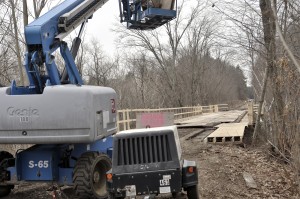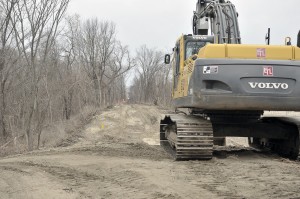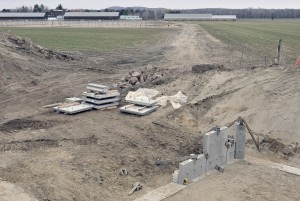
Contractors continue to work on the Westfield Columbia Greenway Rail Trail near the Tin Bridge area off South Broad Street. (Photo by Frederick Gore)
WESTFIELD – City officials are concerned that the regional Transportation Improvement Program (TIP) priority list is shifting away from the North Phase of the Columbia Greenway.
The priority amendment in the TIP budget would commit a substantial amount of federal funding under the Congestion Mitigation and Air Quality (CMAQ) Improvement Program to the Union Station Redevelopment Project in Springfield.

Heavy equipment can be seen clearing brush and debris along the Columbia Greenway Rail Trail last month. (Photo by Frederick Gore)
The use of un-programmed Tip Funding for the Union Station project over the next three years means that approved projects, such as the Columbia Greenway, will have no access to contingency funding, or ability to “pump up” the appropriation of local projects with those uncommitted funds.
The current TIP commitment to the North Phase of the Columbia Greenway bike trail is $2.2 million, while the current engineering estimate to rehabilitate the former railroad bridge over the Westfield River is $2.8 million. The project can proceed under the $2.2 million or be delayed for three years until un-programmed funding becomes available.

New concrete support structures for a new bridge are assembled near the Tin Bridge area of the Columbia Greenway Rail Trail. (Photo by Frederick Gore)
“What we’re hearing is that funding is probably two years away,” Mayor Daniel M. Knapik said this morning. “Money in the DOT (Department of Transportation) account is being diverted, so instead of getting that funding for 2015, we’re now looking at 2016.”
City Engineer Mark Cressotti said that the delay could jeopardize that phase of the rail trail construction.
“The delay, at a minimum is a year and at the worst three years,” Cressotti said. “We could lose the funding, which is an earmark, because if Congress approves a new transportation bill, the existing earmarks go away.”
“The North Phase is an important component leading to the next project which is construction of the Riverwalk trail,” Cressotti said. “It also connects the Columbia Greenway to the city’s north side and Prospect Hill.
The Middle Phase of the rail trail from East Silver Street to Orange Street, which includes replacement or improvements to six bridges, is being financed from a different funding source, Cressotti said.
“The middle section of the trail is programmed for federal funding in 2016 and is on the state DOT list, not the regional TIP list, so I don’t see it competing with regional projects (such as Union Station),” Cressotti said.
The cost of that phase is estimated at $6.7 million because of the number of bridges involved. The bridges over East Silver, Main, Thomas, Chapel and Orange streets will be replaced. The Elm Street Bridge is being preserved.
Cressotti said that the Elm Street bridge will be raised to meet with the state DOT clearance of 14-feet, 6-inches, while the new Main Street bridge will be required to meet Federal Transit Administration (FTA) clearance requirement of 16-feet, 6-inches. The bridges over East Silver, Thomas, Chapel and Orange streets will have clearances of 14-feet, 3-inches.
Cressotti said that the current Columbia Greenway project, the second part of the South Phase, is progressing rapidly with concrete footings being poured for the bridge over South Meadow Street.
“They should start erecting steel by the end of the month,” Cressotti said. “The work on Tin Bridge is also under way as they install the corrugated steel decking on which the concrete would be poured for the trail surface.”

